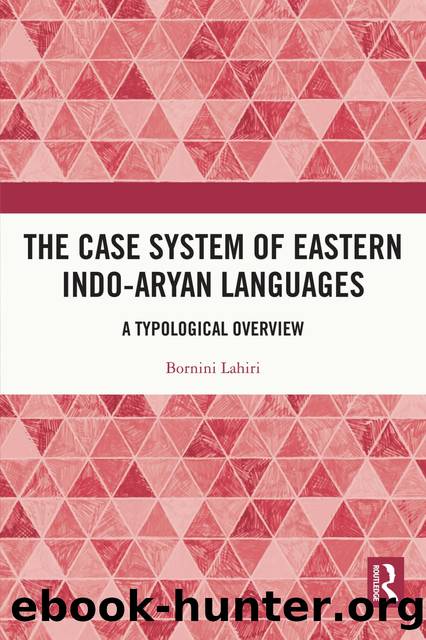The Case System of Eastern Indo-Aryan Languages by Bornini Lahiri;

Author:Bornini Lahiri; [Lahiri, Bornini]
Language: eng
Format: epub
ISBN: 9781000373189
Publisher: Taylor & Francis (Unlimited)
Published: 2021-03-04T16:40:30+00:00
5.2 Markers
Group 1 languages have different genitive markers which depend on the host. All these languages use /ke/ or /kÉ/ to mark the genitive case on nouns.
5.1 ego Éd̪Émi ke d̪Ê-go beÊÉ hÉlÉiË (Mag)
one man Gen two-Clf son Aux
One man had two sons.
5.2 i ÉÊ°urÉ oi lÉrkÉ ke cÊ°ie (Mai)
this bag that boy Gen Aux
This is that boyâs bag.
5.3 kukur ke hÉddi (Bho)
dog Gen bone
Dogâs bone.
5.4 rÉÉ ke hÉÌt̪ʰ mẽ d̪Érd̪ cÊ°Éi (Ang)
Raj Gen hand in/Loc pain Aux
Raj has pain in his hand.
In all these languages, with a singular pronoun /Ér/ or /Ér/ is used. But when the noun is followed by a plural marker then the /ke/ marker is used. In the following sentences the various distributions of the markers can be seen.
5.5 i hÉm-Ér bÉstÉ hÉi (Mag)
this I-Gen bag is
This is my bag.
5.6 i hÉm-Éni ke bÉstÉ hÉi (Mag)
I I-Plu Gen bag is
This is our bag.
5.7 hÉm-Ér matÊ°a d̪Érd̪ bÉiÉÊ° gel ÉicÊ° (Mai)
I-Gen head pain increase went Aux
My headache increased.
5.8 ok-Ér sÉb ke cÉkkÉ (Mai)
it-Obl all Gen wheel
Their wheel.
5.9 roti se hi hÉm-Ér pet bÊ°Ér gÉil (Bho)
chappati Inst Emph I-Gen stomach fill went
My stomach got filled with the chapatti.
5.10 i t̪ohÉ-rÉ log-Én ke bÉstÌªÉ hÉt̪e (Bho)
this you-Obl people-Plu Gen bag is
This is your (plural) bag.
5.11 okk-Ér hÉddi (Ang)
it-Gen bone
Itâs (dog) bone.
5.12 okk-Ér sÉb ke hÉddi (Ang)
it-Obl all Gen bone
Their (dogs) bone.
In Group 2 languages the marker for both the nominal and the pronominal objects are the same; in Asamiya it is /- Ér/, in Bangla it is /-er/ and for Odia it is /-r/.
5.13 nÉd̪i-r pÉni xÉgÉr-Ér nisinÉ nÉhÉj (Asa)
river-Gen water sea-Gen like Neg
Riverâs water is not like seaâs water (The water of the river is not like that of the sea).
5.14 ei-boɾ Ém-Ér beg (Asa)
this-Plu we-Gen bag
These are our bags.
5.15 bone-r pÉ-e kÊ°ub bætÌªÊ°É (Ban)
sister-Gen leg-Loc very pain
Sisterâs leg has pain in it (My sisterâs leg is aching).
5.16 o-r Éut̪o hÉrie gecÊ°e (Ban)
(s)he-Gen shoe lost went
Her/his shoe is lost.
5.17 kukur-maÅÉnko-r hÉɽ (Odi)
dog-Plu-Gen bone
Dogâs bone.
5.18 ei-tÉ t̪É-r ÉÊ°ulÉ (Odi)
it-Clf (s)he-Gen bag
It is her/his bag.
However, in Odia it can be seen that the genitive marker is mostly dropped for non-humans. The use of gentive in such a position does not make the sentence ungrammatical, but in fluent speech it is not used in the following constructions.
5.19 tÌªÉ hÉɽ (Odi)
it bone
Itâs (dog) bone.
5.20 t̪É-ÅkÉ cÉkkÉ (Odi)
it-Plu wheel
Itâs (carâs) wheel.
It may be said that non-human entities are ranked at a lower position in the animacy heicharchy scale, which diminishes their capacity to possess. When the LM is inanimate then it does not possesses the TR in Odia; rather, the LM becomes the body and the TR behaves like a part of the LM. Hence, a compound word construction is formed (see Table 5.1).
Table 5.1 Genitive markers in these languages
Download
This site does not store any files on its server. We only index and link to content provided by other sites. Please contact the content providers to delete copyright contents if any and email us, we'll remove relevant links or contents immediately.
| Anthropology | Archaeology |
| Philosophy | Politics & Government |
| Social Sciences | Sociology |
| Women's Studies |
The Leavers by Lisa Ko(6460)
Born to Run: by Christopher McDougall(6249)
iGen by Jean M. Twenge(4693)
Sapiens by Yuval Noah Harari(4528)
The Kite Runner by Khaled Hosseini(4415)
Spare by Prince Harry The Duke of Sussex(4188)
Bullshit Jobs by David Graeber(3171)
Livewired by David Eagleman(3113)
Goodbye Paradise(2949)
Never by Ken Follett(2871)
A Dictionary of Sociology by Unknown(2516)
Harry Potter 4 - Harry Potter and The Goblet of Fire by J.K.Rowling(2413)
The Club by A.L. Brooks(2350)
People of the Earth: An Introduction to World Prehistory by Dr. Brian Fagan & Nadia Durrani(2345)
The Social Psychology of Inequality by Unknown(2304)
Machine Learning at Scale with H2O by Gregory Keys | David Whiting(2263)
Harry Potter and the Order of the Phoenix (5) by J.K. Rowling(2224)
0041152001443424520 .pdf by Unknown(2213)
Harry Potter and the Deathly Hallows (7) by J.K. Rowling(2213)
